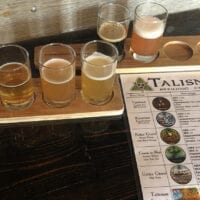
It’s not a Halloween trick. In fact, Utah craft beer drinkers will go to bed tonight knowing a special treat will be waiting for them Nov. 1. That’s when 5% beer will available on draft and in grocery and convenience stores throughout the state.
Utah’s longstanding so-called “3.2 Law” will be nothing but a ghost when the clock strikes midnight.
“Breweries are excited to be able to bring more variety to the consumer,” says Nicole Dicou, executive director of the Utah Brewers Guild, which represents the state’s 32 craft breweries. “There’s always going to be headaches with alcohol policy in Utah, but change brings new possibilities and I think that’s what people are excited about.”
Subscribe for Free: Our e-newsletter subscribers receive a monthly dispatch filled with all sorts of Utah Beer News. They’re also eligible for exclusive giveaways and other fun stuff. 🍻
5% Beer Outside Utah Liquor Stores: A Historic Moment
 For the past 86 years, only 3.2% alcohol by weight beer (which is 4% alcohol by volume, a more common measure) has been allowed to be sold in retail locations. State-run liquor stores sell higher-alcohol — “heavy beer” — products.
For the past 86 years, only 3.2% alcohol by weight beer (which is 4% alcohol by volume, a more common measure) has been allowed to be sold in retail locations. State-run liquor stores sell higher-alcohol — “heavy beer” — products.
But beginning Nov. 1, the state’s grocery and convenience stores will be allowed to sell beer containing up to 5% ABV. Bars, restaurants, and other spots with sufficient licensing will be able to sell it on draft.
“This is a step in the right direction,” says Chad Hopkins, brewer at Hopkins Brewing Co. in Sugar House. “It’s hard to brew most beers ‘to style’ with the 4% limitation. A proper pale ale needs to be at that 5% ABV mark. That little bump in alcohol really helps the malt backbone and hop profile pop in some styles.”
Euphoric anticipation is enveloping Utah’s craft beer community. And why not? Nov. 1 promises to be a historic day.
- Brewers are tinkering with longstanding, successful 4% beers and bumping them to 5%.
- New beers brewed specifically for the occasion are hitting taprooms, tap handles, and store shelves.
- At least one Utah brewery is refreshing its look to mark the occasion.
- Even Anheuser-Busch InBev — an Evil Empire in many craft beer circles — sent its iconic Budweiser Clydesdales to Utah to lead a funeral procession for 3.2 beer.
It’s not all euphoria for brewers, however.
With the increase in alcohol content also comes an increase in taxes the brewers pay. The new law calls for a tax increase to $13.10 per barrel (31 gallons). That’s up from $12.80, which already was the highest in the country, according to Dicou.
Read how the new law opens doors for new brews, via UtahStories.com.
A 5% Balancing Act
Breweries are balancing enthusiasm with practicality. The slight increase in alcohol means new recipes, updated packaging and labels, and perhaps even increased battles for shelf space at various retailers.
 “The reformulation process has been complex but welcome,” says Brian Ericksen, head brewer at Bohemian Brewery. “The challenge has been to keep the primary characteristics, flavor, and profile that our customers (and us) have come to love while delivering a product that is brewed up to the new ABV limit.”
“The reformulation process has been complex but welcome,” says Brian Ericksen, head brewer at Bohemian Brewery. “The challenge has been to keep the primary characteristics, flavor, and profile that our customers (and us) have come to love while delivering a product that is brewed up to the new ABV limit.”
From an operations standpoint, the switch touches “almost every aspect” of Bohemian’s business.
Timing is also a delicate dance for brewers who don’t want to be stuck with a bunch of 4% beer after Nov. 1, but who also don’t want to run out before then.
“It’s going to be difficult to taper off production of 4% beer without running out,” says Mark Medura, owner of Level Crossing Brewing Co. “Like many local breweries, we are trying to walk that line — we don’t want to end up with a surplus of 4% beer but we don’t want to run out before Oct. 31, either.”
For Talisman Brewing, as is likely the case with other breweries, the changeover isn’t as simple as flipping a switch.
“The change will not all occur right on Nov. 1,” says Joann Williams, co-owner of the Ogden-based brewery. “(It’ll be) more of a rolling change as we move through product and replace it with the new higher ABV.”
‘Make Room for 5%’ Beer Deals
One happy consequence leading up to the law change, at least for beer drinkers, is the ability to help some breweries “liquidate” their inventory of 4% beers before November hits.
- Level Crossing Brewing Co. is promoting a “kill the keg” event through Oct. 31, discounting select 4% drafts at its South Salt Lake taproom.
- Salt Lake’s Kiitos Brewing and Ogden’s UTOG Brewing are selling cases (24 beers) for $20 to help supercharge sales for several of their flagship beers.
- Uinta Brewing touted an “End of an Era Beer Clearance,” with deals on its 4% beers at its Salt Lake General Store through October.
- Roosters Brewing is selling $1 cans of two of its popular brews: Blood Orange IPA and Bee’s Knees Honey Wheat.
- Shades Brewing is selling $4 six-packs and offering $5 growler fills and $1 Publican Pale Ale pints at their taproom/bottle shop.
- Even state-controlled liquor stores are getting in on the discounting, according to Ben Winslow of FOX 13. And, come Nov. 1, whatever 4% beer is left on liquor store shelves gets dumped, according to an article by Kathy Stephenson in The Salt Lake Tribune.
That’s not to say beers under 5% ABV will now be obsolete in Utah. It depends on the style, brewers say. Bohemian’s Czech Pilsener, for example, will be boosted to 4.8% from 4% to “stand alongside the great Czech Pilseners of the world.”
New, Existing Beers Get 5% Treatment
The majority of breweries are planning to reformulate most, if not all, their 4% beers. Many, including Kiitos Brewing, Policy Kings Brewery, RoHa Brewing Project, Wasatch Brewery, and Uinta Brewing, are also developing new beers to capitalize on the new 5% law. And it appears a Cerveza Zólupez Beer Company sampler pack will now be available in grocery stores.
For some, it meant tweaking the recipe of a multi-award-winning beer.
 “Our biggest concern was Cutthroat (Pale Ale),” says Jeremy Ragonese, president of Uinta Brewing. “Toying with the profile of a flagship beer that was specifically designed to be full-flavored at the levels our laws would allow was certainly cause for concern within the brewery.”
“Our biggest concern was Cutthroat (Pale Ale),” says Jeremy Ragonese, president of Uinta Brewing. “Toying with the profile of a flagship beer that was specifically designed to be full-flavored at the levels our laws would allow was certainly cause for concern within the brewery.”
Nevertheless, the increase allows for certain beers to conform to style guidelines set by the Beer Judge Certification Program (BJCP).
“The beers obviously benefit from improved flavor and mouthfeel, which means the customer also benefits from a beer that tastes more as the brewer intended,” Ragonese says. “We brew a lot of IPAs, and at 4% ABV the challenge was always how to create a unique profile that stood out knowing the typical IPA drinker is very discerning and looking for more body to support the abundance of hops.”
For a brewery such as Bohemian, which specializes in lagers, it calls the new law “a win for everyone.”
“The greatest thing about the change to Utah state law is that it finally allows us, in most cases, to brewer our heritage lager beers true to style,” Ericksen says. “For our customers, this means that they are finally getting beers consistent in strength and hop profile with the classic and legendary lagers and ales of the world, but made to our exacting standards on a local craft level.”
One Small Step…
One catalyst for the law change came from big breweries outside the state. This year, Utah saw certain beers disappear from store shelves as national brewers discontinue their 4% ABV beer offerings.
Earlier in 2019, as the Utah Legislature debated increasing the limit first to 6% and then to 5%, the Utah Brewers Guild said its members were concerned the “legislation would benefit out-of-state breweries at the expense of small, locally-owned breweries who employ thousands of Utahns.”
The legislation proved to be divisive within the craft beer community.
Some beer drinkers suggested even a minimal increase would be beneficial. Others, meantime, believed the proposed increase to be an arbitrary number that would help macro-brewers more than local brewers. Some worried that Utah could see more of the national brands’ “craft” products competing with locals on store shelves.
Brian Coleman, the owner of 2 Row Brewing, wasn’t concerned then and he isn’t worried now.
“I’m getting new shelf space all over the place,” he says. “We’re going into Smith’s for the first time and some other places. Things are just getting better and better.”
Though Hopkins Brewing doesn’t currently package its beer, its namesake brewer recognizes the effect the increase could have on business.
“We struggle with guests who only want ‘high point’ bottles or cans. This really helps us get closer to giving the guest a beer style they’re seeking,” Hopkins says. “I’m hoping this will open the doors for continued progress and we can one day serve a beer on tap without limitations.”
Related: 5% Articles on Utah Beer News
- Feb. 6, 2019: Will Utah do Away with its 3.2% Beer Law
- March 15, 2019: Say Goodbye to 3.2% Beer Law in Utah
- Oct. 25, 2019: Get Ready for 5% (Utah Beer News E-Newsletter)




